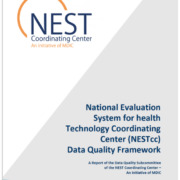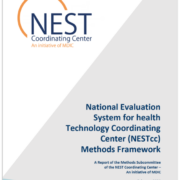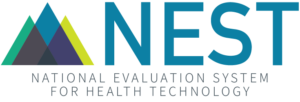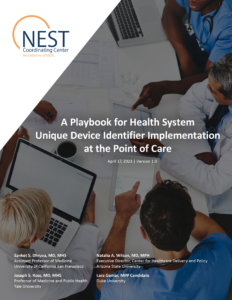NESTcc publishes ‘A Playbook for Health System Unique Device Identifier Implementation at the Point of Care’
The United States Food and Drug Administration (FDA) Unique Device Identifier (UDI) is a system to identify medical devices sold in the United States from manufacturing through supply chain to patient use. Specification of the system has been accomplished through both legislation and FDA rulemaking. A UDI is now available on all low, moderate, and high risk devices, barring exemption, exception, alternative or lack of compliance. Significant investments have been made to label devices with the UDI, which identifies device manufacturer, device-specific information (e.g., model), and production-specific information (e.g., lot number). Use of the UDI provides many
benefits to improve the safety and delivery of patient care through applications in clinical decision-making, in recall management, and in health system operational functions that underpin safe and high-quality clinical care. Availability of the UDI advances device surveillance and other assessments of the safety and effectiveness of medical
devices through real-world data (RWD) sources, for which the National Evaluation System for health Technology Coordinating Center (NESTcc) has been created.
Optimizing the potential for this multitude of benefits requires that the UDI be captured at the point of care (POC) by health system information technology (IT) systems. To date, however, only a limited number of health systems have taken steps to capture UDI data electronically at the POC and use that data as the single “source of truth” regarding medical device utilization in patient care. A burgeoning body of literature and expertise have developed from the limited “end-to-end” UDI implementations that provide critical insights to describe and guide the specifics for health system UDI implementation at scale.
In this setting, the UDI Playbook was created for NESTcc health system research network collaborators (and more broadly, for all health systems) to advance UDI implementation at the POC and UDI availability in RWD sources in their respective health systems. This will serve to augment real-world evidence (RWE) generation about medical devices for improved patient care and safety.
The Playbook is divided into the following sections: Introduction, Defining Steps, Implementation Planning, Implementation Development, Implementation, Sustainability and Advancement, UDI Use, Conclusion, References, and Appendix. The latter includes a checklist, one-pagers, and presentation templates for health system use.
DOWNLOAD THE PLAYBOOK
– YOU MIGHT ALSO BE INTERESTED IN –
